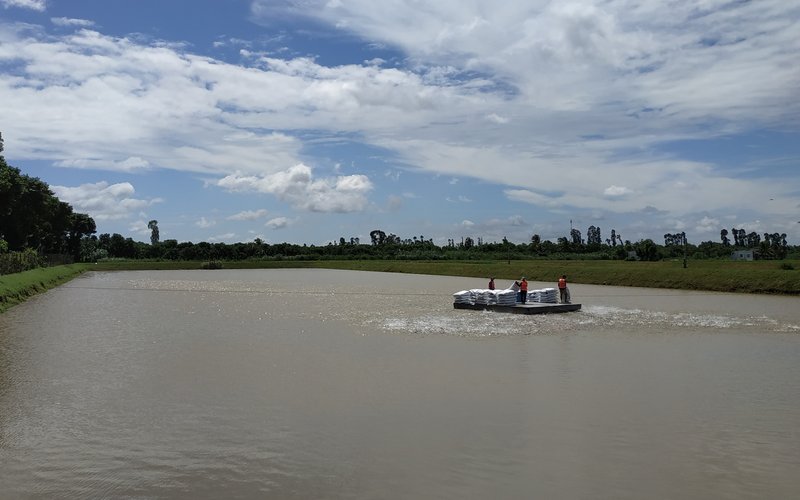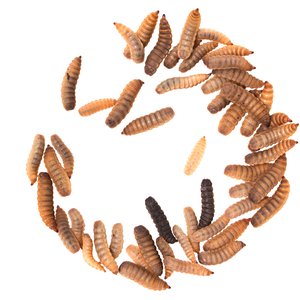In this last part of the series, we will discuss how the fishmeal and fish oil shortage and high prices are impacting the aquafeed industry and the potential effects on aquafeed producers and farmers in the medium term.
Costs and feed prices
“Aquafeed accounts for up to 70% of production costs and up to 80% of a producer’s environmental footprint. In the last year, reports mention that aquafeed prices have increased up to at least 30%, which is partly a result of geopolitical issues, energy price increases, and further susceptibility due to the limited raw materials basket, especially in the Norwegian salmon feed market. With a future rise of climate warming, predictions suggest that the prices of key commodities will further increase,” said Louise Buttle, Sustell lead for aqua and global key account manager, dsm-firmenich.
“The current context will have different levels of impact depending on the species, regions and procurement strategies adopted by each company. Companies with good purchasing power and supply planning can navigate relatively well during the tight market period. However, smaller feed mills may face more difficulty accessing raw materials in quality and quantity,” said Cinzia Boggino Scavone, global business development manager - aquaculture, Zinpro.
There is also a difference between premium and low-value species and commodity markets. “In the first case, the increased cost of feeds can eventually be partly transferred across the value chain to the consumer, who is more willing and able to pay a premium price to continue consuming these products. However, it also depends on how long and severe the shortage will be, considering there will be increased competition with other animal farming sectors for feed ingredients. In the case of high-quality ingredients, we also need to consider the competition with the pet food market, which is a huge and growing market worldwide, able to pay a premium for ingredients, squeezing cost and availability further,” said Sofia Morais, innovation aqua team leader at Lucta.
Fishmeal prices have been increasing during the past 18 months. “Aquafeed prices will increase and are already increasing in places like China where fishmeal is used at high inclusion rates. Peruvian fishmeal price increases will have a domino effect on other fishmeal prices as customers look for alternative suppliers,” said Louis Rens, SVP global ingredients sales, Green Plains.
“It really is a question of supply and demand. We are experiencing a turbulent cycle in rising prices of feed ingredients which is forcing feed companies to raise feed prices. At the same time, producers are not always able to raise their own prices due to stagnating consumer demand and competition from other food protein sources. Experience has shown that such cycles, supported by innovation and consolidation of the industry, lead to improvements in the cost-effectiveness of the value chain that allows restoring the balance between supply and demand,” Petter Cotteau, business unit director aquaculture at Adisseo, said.
“The assessment of the increase in prices of aquafeeds depends on various factors, including raw material supply, market demand, and the industry's ability to adapt to changes. While aquaculture feed prices may face short-term challenges due to fishmeal scarcity, in the medium and long term, the industry has the capacity to adapt, develop sustainable alternatives, and maintain competitive prices. Research, development, and the acceptance of these alternatives will play a crucial role in determining the future of the aquafeed industry,” said Robson Sfaciotti Barducci from Biorigin R&D.
“The global fish oil supply has been around one million MT for the last ten years while the demand increases by approximately 2-4% annually. Therefore, an additional 20,000-40,000 tonnes is needed every year. This is the time for action. In a scenario where the industry does not adopt new tools further, we can anticipate a shortage as significant as 300,000 tonnes in ten years,” said Ruud Peerbooms, president algae ingredients at Corbion. “The ever-increasing demand for omega-3 versus stagnant supply will over time, further increase the value of omega-3. This trend has been visible over the past few years, also when you take out the recent strong peaks. Algae oils are able to facilitate long-term agreements that offer security, stability and predictability for feed manufacturers and aquaculture producers.”
“The current volatile market conditions for all feed ingredients shouldn’t distract feed manufacturers from investing in responsibly sourced and produced ingredients. Responsible practices, ending up being recognized as such by a certificate from a well-established standard, are a long-term investment and a powerful market driver, serving as an indicator to consumers and an incentive to all stakeholders that continuous improvement is required. Investment is meant here not only in financial terms but also in terms of efforts to convene relevant stakeholders and convince them that long-lasting efforts are in everyone’s interest,” said IFFO’s director general, Petter Martin Johannessen. “Almost half of all marine ingredients produced globally are certified as being responsibly sourced and produced against the MarinTrust standard. Furthermore, the share of marine ingredients produced using fish byproducts as raw materials keeps increasing: 33% of fishmeal and 54% of fish oil (2022).”
Farmers
The current high feed prices are affecting farmers in different ways depending on the species. “The shrimp industry has already lowered its density to cope with challenges during the COVID-19 period, allowing for the reduction of the fishmeal as well as protein content in the diet, so it might be more resilient to these price increases. Nevertheless, a country like Ecuador, which already suffered three price increases, might be facing another one in the coming month,” said Pierre Fortin, aquaculture manager at Techna. “Mediterranean seabream is facing a similar issue regarding selling prices remaining low and is facing tough times because production is higher than demand. Moreover, they have a more limited possibility to adapt since Mediterranean species still require important levels of fishmeal and omega-3s in their diet, so the challenge for them is bigger and a price increase might be inevitable.”
“Adjustments to crude protein levels and densities are necessary. This situation should spur feed manufacturers to optimize their formulations but also encourage farmers to improve feed management by optimizing distribution methods, for example, and no longer accepting excessively high FCRs,” said Herve Lucien Brun from Jefo aquaculture team.
“There is also an increasing dialogue, less around the price tag of a bag of feed, and increasingly considering the value brought by a given feed. In this way, farmers see this more as an investment, with an expected return,” said Guillaume Salze, senior aquaculture nutritionist at KnipBio.
Innovation driver
“Global demand for all animal feed is forecast to expand by some 200 MM mt by 2050. The demand for feed ingredients will likely grow faster than feed supply. Fishmeal and fish oil have essentially reached peak supply. This demand growth will drive higher feed ingredient prices. Therefore, new sources of high-quality protein must be developed to support long-term industry growth,” said David Dzisiak, chief operating officer at Botaneco.
“This situation is a strong driver towards more innovation through better use of existing and locally sourced raw materials, through increased use of functional feed additives and upscaling of production capabilities of novel ingredients, but also towards a consolidation effect that is likely to affect the overall aquaculture industry rather than just the aquafeed industry,” said Marleen Dehasque, global product manager Aqua Nutrition at Adisseo.
“The shortage of ingredients will hopefully drive the development of novel more sustainable ingredients which can lead to the possibility of making more sustainable feed. Prices for novel ingredients will be more competitive with time as they scale production and get unit costs down. Also, as more ingredient providers enter the market, more competition will drive down ingredient prices,” said Ragnhild Dragøy, VP product management & sustainability at Aker BioMarine.
“The tight supply will only accelerate the development of diverse formulation strategies and the process of new nutritional technologies adoption, that have already taken place in the industry in the past few years. There will be a lot of gains to be uncovered by increasing feed formulation accuracy, utilization of feed additives as a usual tool rather than a specialty for differentiated diets, and the integration and adoption of smart feeding technologies and automation at the farm level,” said Otavio Serino Castro, global marketing manager – Aquaculture at Zinpro.
“We must underscore the aquafeed industry finds itself at a pivotal moment in its evolution. The ongoing challenges related to fishmeal and fish oil supply highlight the imperative need for innovation, sustainability, and adaptability. As we steer through these transformations, fostering collaboration among industry stakeholders, researchers, and alternative ingredient suppliers becomes paramount in securing a resilient and sustainable future for aquaculture. Moreover, the growing consumer demand for responsibly sourced seafood further underscores the urgency of these advancements, compelling the aquafeed industry to persist in the exploration and integration of innovative alternative solutions,” said Javier Polo, vice president of APC.
“The aquafeed industry is robust and innovative. We are working with several aquafeed manufacturers to use this as an opportunity to make higher quality, more sustainable feeds that add more value to producers. Although the supply shortages present challenges, especially when they involve a gold standard ingredient like fishmeal, the industry will become even more robust in the medium term in the face of this challenge,” Mark Luecke, CEO of Houdek, said.
The medium term
“In the medium term, fisheries will recover and liquidity will eventually return to fish oil supply markets and fish oil prices will fall back from their peak. To what extent they will fall back is anyone's guess. However, with this crisis, the industry has now seen firsthand the financial and operational risk that it carries when dependency on critical nutrients is concentrated on just one source. Therefore, we expect the demand for alternative sources like algal oil to continue to grow in order to ensure a sustainable platform for the growth of aquaculture as a healthy and sustainable food system,” said Ian Carr, global business development manager at Veramaris.
“In the short- to mid-term, it can be expected that existing new technologies (algae, insects, single-cell, etc.) will mature, and perhaps there will be an emergence of even more approaches. Products that can offer a variety of performance benefits, that are highly traceable and potentially be derived from a variety of feedstocks, including ultra-low carbon intensities, will be advantaged. The trends of consolidation and integration are likely to continue and with that, economies of scale reached within the industry may lead to advantages not currently seen in today’s fragmented sector,” said Larry Feinberg, CEO and co-founder at KnipBio.
“We estimate that wise feed formulators will accept some short-term losses in order to retain stability over a longer period of time. This may lead to increased consolidation, which could lead to an amplification of the alternative aquafeed ingredient strategy via economies of scale,” said David Tze, CEO of Novonutrients.
Other stakeholders predict aquafeed prices to remain high. “I believe aquafeed prices could be under continued pressure to elevate in price, especially those diets which are utilizing high inclusions of fishmeal or fish oil. Firstly, continued demand and production growth within the pet food industry, which is also seeking to utilize these ingredients and whose customer base has a higher ability and willingness to pay for the available supply. Secondly, the current slate of alternative fats for fish oil is cost or supply limiting to many feed formulators at this time, but I am confident the pace of innovation and technology will continue to lower costs of alternatives or bring forth new products at a faster pace, then the constraint may become regulator approvals and customer adoption, as they prepared to evaluate and innovate at the same speed to support the growth,” said Derek Balk, director of High Protein Ingredients & Business Development at POET.
“It is likely that the aquafeed prices will remain high or increase in the coming few years unless there are significant changes in the supply and demand of the feed ingredients or the aquaculture products. In the alternative ingredient space, the challenges in scaling up the production, consistent quality, regulatory approval and consumer acceptance would keep the price point considerably high,” said Ezhil Subbian, CEO of StringBio.
“In the medium term, the aquafeed industry will need to adapt to these dynamic changes by focusing on sustainability, innovation, cost-effectiveness, and compliance with evolving regulations. Continued research and development efforts to optimize feed formulations, reduce environmental impacts, and meet the nutritional needs of different species will be critical for the industry's growth and sustainability,” Alex Diana, product manager aquaculture at Innovafeed, said.
“There is rising pressure on the aquaculture industry to reduce its impact on biodiversity, water quality, land use and antibiotic pollution. This has led to further intensification of the industry, the emergence of closed production systems, alternative disease prevention strategies and a search for higher operational efficiency, through better control of the environment and precision feeding. There is no doubt that the financing needed to achieve this will result in further consolidation of the sector,” said Olivier Hartz, commercial development lead at Unibio, said.
”In the near future, the primary focus will shift towards animal health and nutrition geared towards strengthening the immune system and performance. This would involve providing conditions for animals to have a more active and prepared immune system to face daily challenges without the need for antibiotics or other drugs for pathogen prevention,” said Fernando Souza, Technical Coordinator for Monogastrics at ICC.
“The aquaculture industry’s focus must remain on increasing society’s awareness of seafood’s important role in the diet to increase consumer demand and improve the economics across the aquaculture supply chain. An increase in aquafeed prices should be driven by an increase in value to the producer by delivering higher quality feed products using higher quality feed ingredients,” Luecke concluded.
Don't miss the previous articles in this series:
Fishmeal and fish oil shortage I: What are the alternatives?
Fishmeal and fish oil shortage II: Formulation in challenging times










